Understanding ISP coverage is essential for consumers seeking reliable internet service. By utilizing various tools and resources, individuals can evaluate available providers in their area, assess service quality, and make informed decisions based on real-time data and user experiences. These insights are crucial for navigating the complexities of broadband availability and performance.
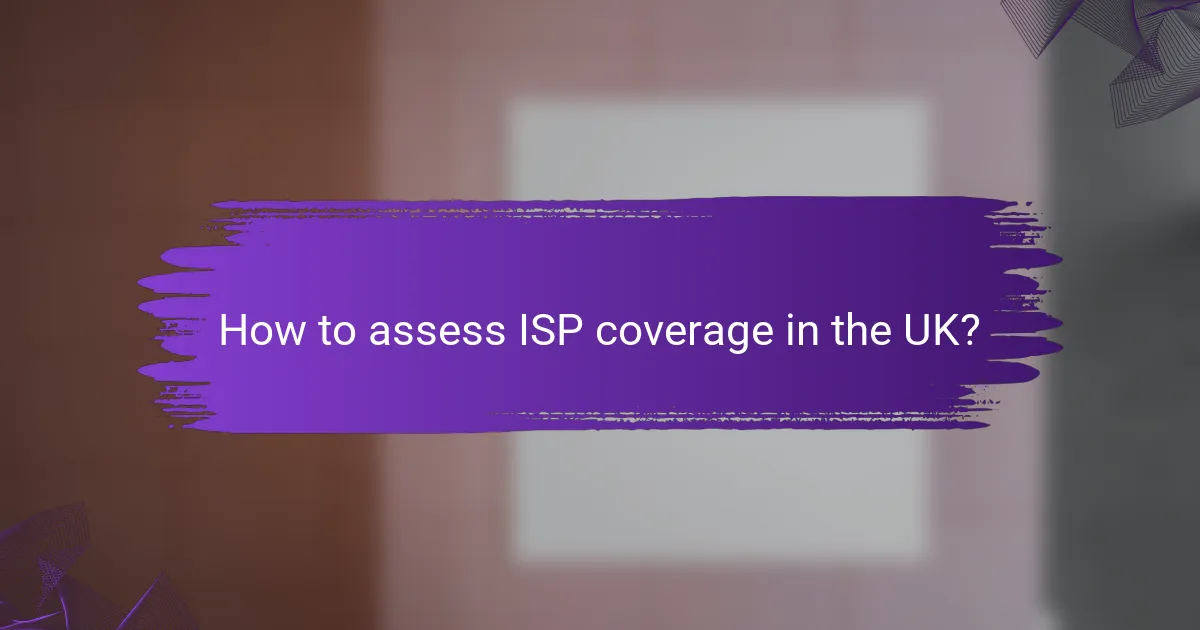
How to assess ISP coverage in the UK?
To assess ISP coverage in the UK, start by identifying available providers in your area and their service quality. This can be done through various tools and resources that map broadband availability and user experiences.
Use Ofcom’s broadband coverage maps
Ofcom provides comprehensive broadband coverage maps that allow users to visualize the availability of different ISPs across the UK. These maps display the types of broadband services available, such as fiber, DSL, and cable, helping you determine which options are accessible in your location.
To use the maps effectively, enter your postcode and explore the coverage for each provider. This tool can help you compare the reach of major ISPs and identify areas with limited service options.
Check local ISP websites
Visiting local ISP websites is another effective way to assess coverage. Most ISPs offer a coverage checker tool where you can input your address to see what services are available. This information is often more up-to-date than general maps.
When checking these websites, pay attention to the details regarding speed estimates and any promotional offers. Some ISPs may provide additional services like bundled packages that can enhance your internet experience.
Utilize community feedback platforms
Community feedback platforms, such as forums and review sites, can provide valuable insights into ISP performance in your area. Users often share their experiences regarding speed, reliability, and customer service, which can help you gauge the quality of service.
Look for platforms that allow users to rate their ISPs and leave comments. This real-world feedback can highlight potential issues or advantages that coverage maps and ISP websites may not fully convey.
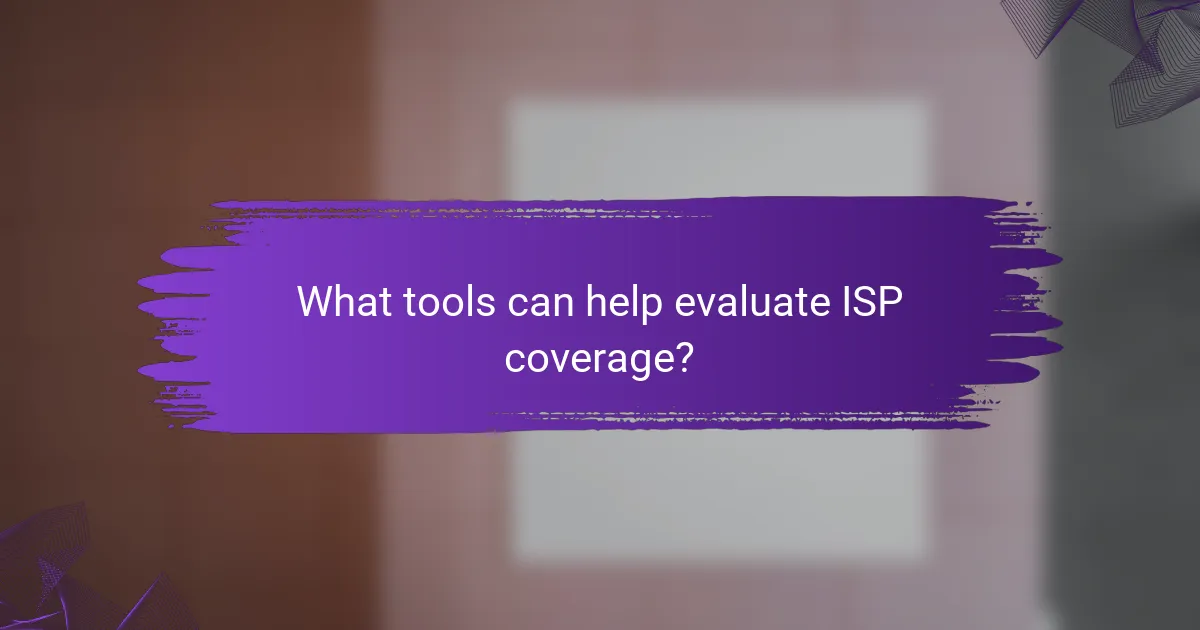
What tools can help evaluate ISP coverage?
Several tools can effectively evaluate ISP coverage, providing insights into network performance and availability. These resources help users assess their options based on real-time data, Wi-Fi analysis, and service comparisons.
OpenSignal app for real-time data
The OpenSignal app offers real-time data on mobile network performance, including coverage maps and speed tests. Users can see how different ISPs perform in their area, helping them make informed decisions about their internet service.
One key feature is the ability to view user-generated coverage maps, which reflect actual experiences rather than just advertised speeds. This can be particularly useful in urban areas where coverage can vary significantly from one block to another.
NetSpot for Wi-Fi analysis
NetSpot is a powerful tool for analyzing Wi-Fi networks, helping users identify coverage gaps and optimize their home networks. It provides detailed heatmaps that visualize signal strength, allowing users to pinpoint areas with weak connectivity.
When using NetSpot, consider conducting a site survey to gather comprehensive data about your Wi-Fi environment. This will enable you to make adjustments, such as repositioning routers or adding extenders, to improve overall coverage.
Broadband Genie for comparison
Broadband Genie is an online resource that allows users to compare different ISPs based on various criteria, including speed, price, and customer reviews. This comparison tool is particularly useful for those looking to switch providers or find the best deal in their area.
When using Broadband Genie, take advantage of filters to narrow down options based on your specific needs, such as budget or required speed. This can help streamline the decision-making process and ensure you choose a service that meets your requirements.
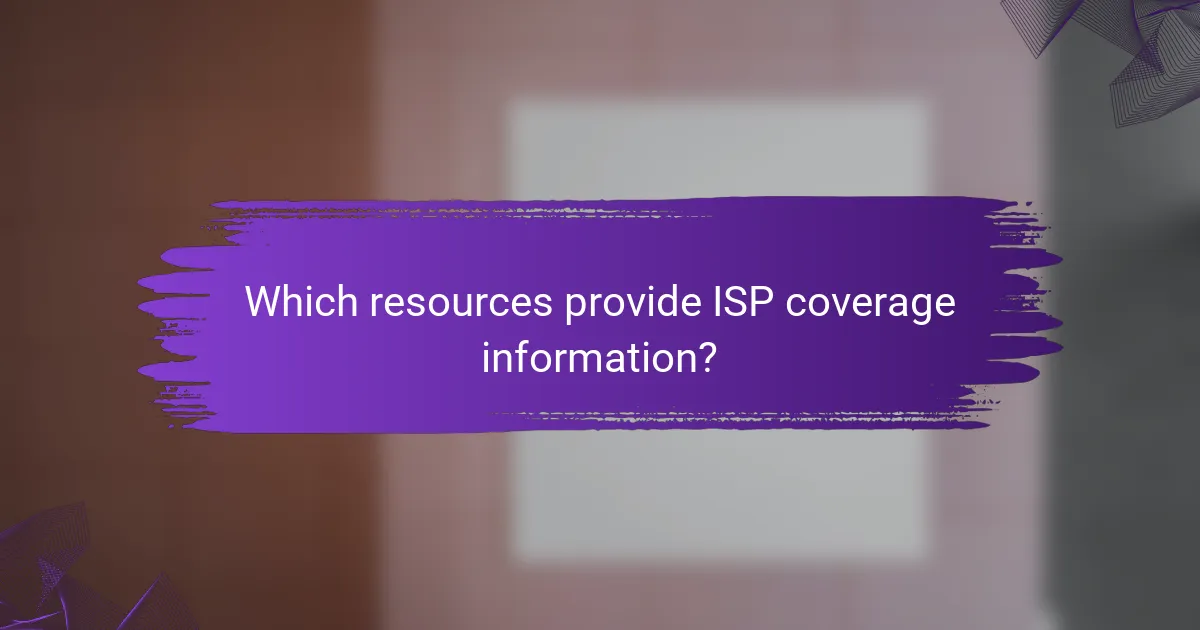
Which resources provide ISP coverage information?
Several resources offer valuable information on ISP coverage, helping consumers assess their options. These include government reports, initiatives, and consumer advocacy websites that provide insights into broadband availability and quality.
Ofcom reports on broadband availability
Ofcom, the UK’s communications regulator, publishes regular reports detailing broadband availability across the country. These reports include data on the types of broadband services available, such as fiber, ADSL, and cable, as well as coverage maps that illustrate service reach.
Users can access these reports on the Ofcom website, which often includes interactive tools for checking specific areas. This information is crucial for understanding where high-speed internet is accessible and identifying potential service gaps.
UK government broadband initiatives
The UK government has launched several initiatives aimed at improving broadband access nationwide. Programs like the Gigabit Broadband Voucher Scheme provide financial support to households and businesses to upgrade to faster internet connections.
Additionally, the government’s commitment to achieving universal broadband coverage by a set date means ongoing investments in infrastructure. Staying informed about these initiatives can help consumers take advantage of available funding and support for better connectivity.
Consumer advocacy websites
Consumer advocacy websites, such as Which? and Uswitch, offer tools and resources for comparing ISPs and their coverage. These platforms provide user reviews, speed tests, and detailed comparisons of service plans, helping consumers make informed decisions.
These websites often feature guides on how to check ISP availability in specific locations, as well as tips on negotiating better deals with providers. Utilizing these resources can enhance the chances of finding the best internet service tailored to individual needs.
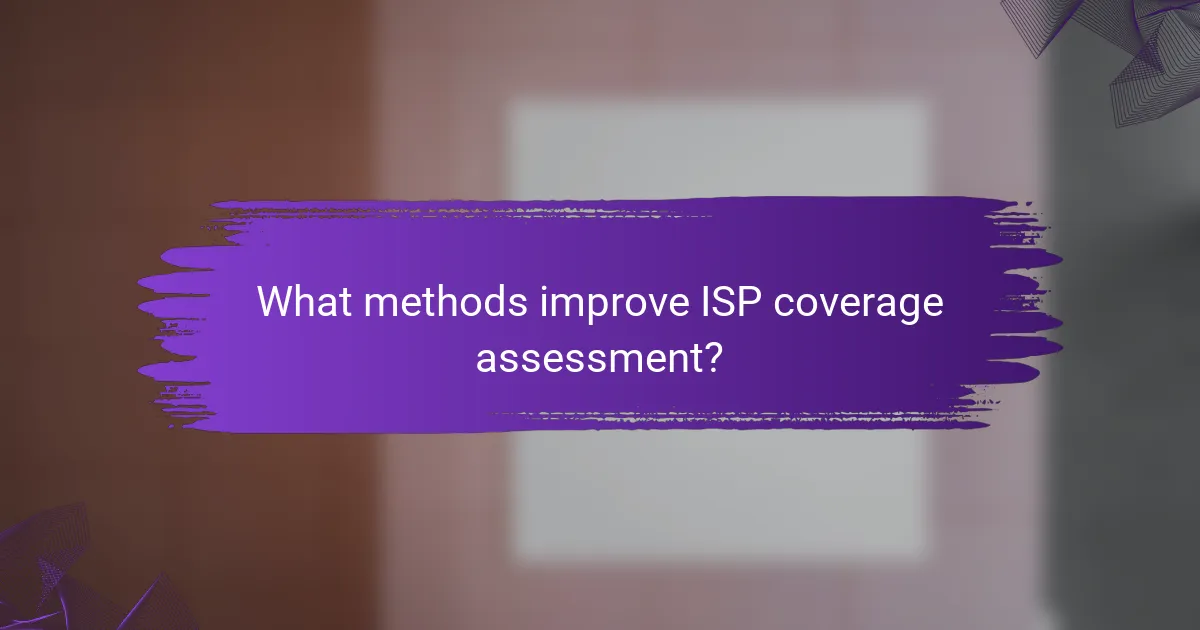
What methods improve ISP coverage assessment?
Improving ISP coverage assessment involves utilizing various methods that provide insights into service quality and availability. Key approaches include conducting speed tests, analyzing historical data, and engaging with local community forums to gather firsthand experiences.
Conduct speed tests in various locations
Conducting speed tests in different locations is essential for assessing ISP coverage effectively. Use reliable tools like Ookla Speedtest or Fast.com to measure download and upload speeds, as well as latency. Aim to test during different times of the day to capture variations in performance.
When testing, consider both indoor and outdoor locations to understand how physical barriers affect connectivity. Record your results systematically to identify patterns and areas with consistently poor performance.
Analyze historical data trends
Analyzing historical data trends can provide valuable insights into ISP performance over time. Look for reports from organizations like the Federal Communications Commission (FCC) or local regulatory bodies that publish aggregated data on ISP speeds and coverage areas.
Utilize tools that visualize historical performance, such as broadband maps or speed test databases. This data can help identify areas where ISPs have improved or declined in service quality, guiding your assessment of current coverage.
Engage with local community forums
Engaging with local community forums is a practical way to gather real-world experiences regarding ISP coverage. Platforms like Reddit, Nextdoor, or local Facebook groups can provide insights into user satisfaction and service reliability.
Ask specific questions about ISPs in your area, and pay attention to recurring issues or praises. This grassroots feedback can help you gauge the effectiveness of different providers and make informed decisions based on community experiences.

What criteria should be considered when choosing an ISP?
When selecting an Internet Service Provider (ISP), consider factors such as coverage area, pricing, contract terms, and customer service reputation. These elements significantly impact your internet experience and can vary widely between providers.
Coverage area and reliability
Coverage area refers to the geographical regions where an ISP provides service. It’s crucial to ensure that the provider covers your specific location, as some ISPs may have limited reach, especially in rural areas. Reliability is equally important; look for ISPs with a history of minimal downtime and strong performance metrics.
Check for coverage maps on the ISP’s website or use third-party tools to verify service availability. User reviews can also provide insights into the reliability of the connection in your area.
Pricing and contract terms
Pricing for internet services can vary significantly based on speed, data limits, and additional features. Compare the monthly fees and any installation or equipment charges to get a complete picture of the cost. Some ISPs offer promotional rates that increase after an initial period, so be aware of the long-term pricing structure.
Contract terms are another critical factor. Some ISPs require long-term commitments, while others offer month-to-month plans. Be cautious of early termination fees that can add to your overall costs if you decide to switch providers.
Customer service reputation
The quality of customer service can greatly affect your experience with an ISP. Research the provider’s reputation for handling customer inquiries and technical support. Look for reviews that mention response times and the effectiveness of their support teams.
Consider ISPs that offer multiple support channels, such as phone, chat, and email, as this can enhance your ability to resolve issues quickly. A provider with a strong customer service track record can save you time and frustration in the long run.
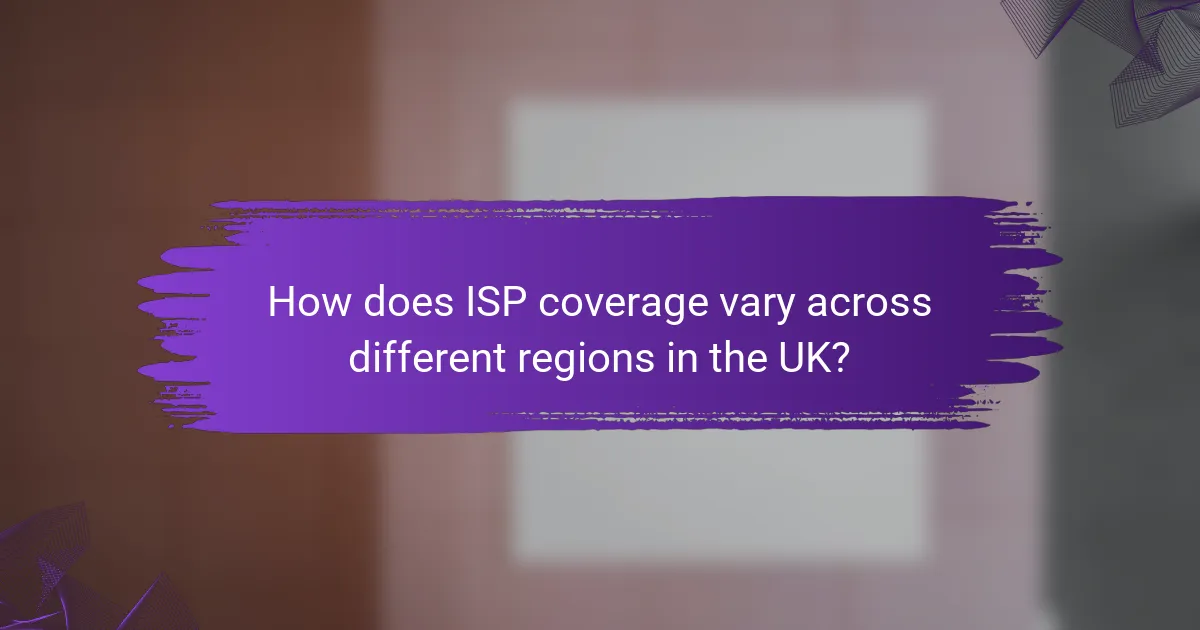
How does ISP coverage vary across different regions in the UK?
ISP coverage in the UK varies significantly between urban and rural areas, primarily due to differences in infrastructure and investment. Urban regions typically enjoy faster and more reliable internet services, while rural areas often face challenges such as limited provider options and slower speeds.
Urban vs rural coverage differences
Urban areas in the UK generally have extensive ISP coverage, with multiple providers offering high-speed broadband options, including fiber-optic services. In contrast, rural regions may have only one or two ISPs available, leading to slower speeds and less reliable connections.
For example, cities like London and Manchester often have access to gigabit internet, while rural communities might only receive standard broadband speeds, sometimes below 10 Mbps. This disparity can affect everything from remote work capabilities to streaming services.
Regional ISP availability
ISP availability varies widely across different regions of the UK, influenced by factors such as population density and local infrastructure. Areas with higher populations, like the South East and Greater London, tend to have a wider range of providers and services compared to regions in Scotland or Wales.
To assess ISP options in your area, consider using online tools that allow you to input your postcode and compare available services. This can help identify the best providers and packages suited to your needs.
Impact of infrastructure investments
Infrastructure investments play a crucial role in determining ISP coverage and service quality. Government initiatives and private sector investments aim to expand broadband access, particularly in underserved rural areas. The UK government has set ambitious targets for nationwide gigabit-capable broadband by 2025.
When evaluating ISPs, consider their commitment to infrastructure development in your area. Providers that invest in upgrading their networks are more likely to offer better speeds and reliability over time, making them a more sustainable choice for long-term internet needs.
